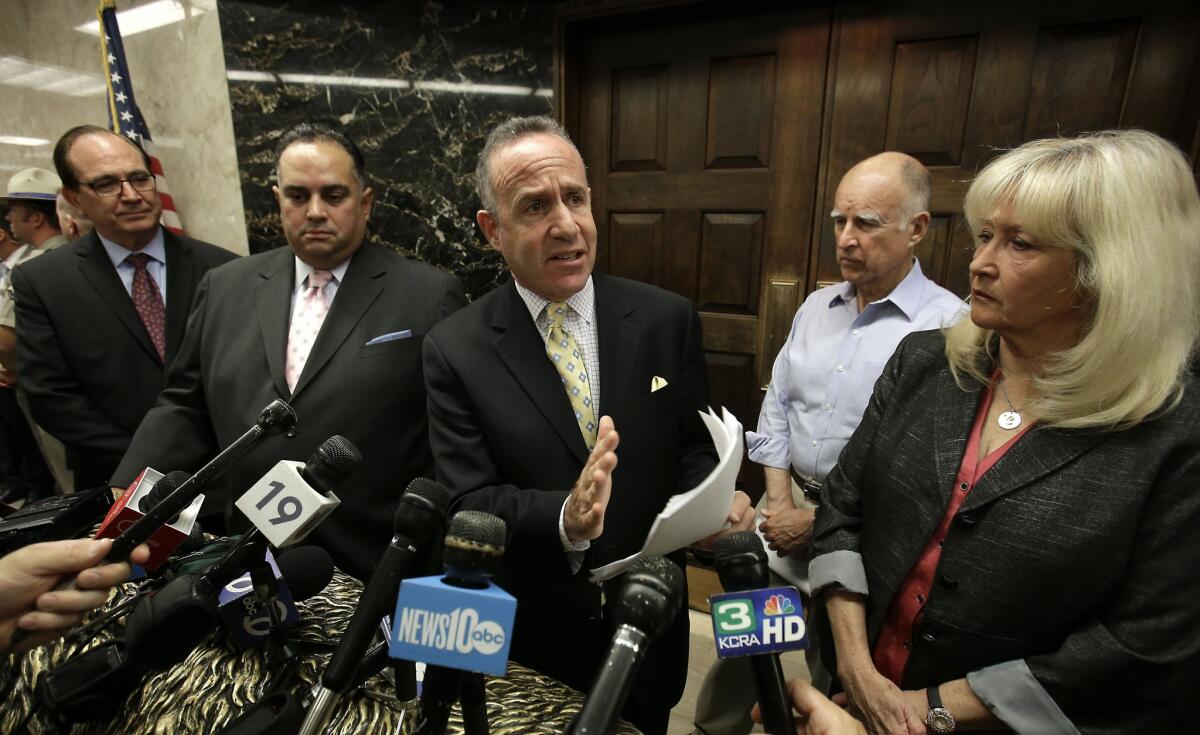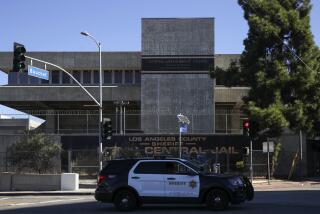Gov. Jerry Brown is big winner in deal to ease prison crowding

SACRAMENTO — Any way you score it, the compromise legislation on California prison crowding is another sweet victory for Gov. Jerry Brown.
The governor, in fact, hasn’t suffered a major defeat at the Capitol in two years.
Credit four factors: Fellow Democrats control the place. Budget bills now require only a simple majority vote. Brown carefully picks his shots, focusing on just one or two issues at a time. He’s not exactly a rookie.
He’s 3-for-3 on big at-bats in the Legislature this year. First there was his landmark changing of the school funding formula to spend more money on poor kids and English learners. Then he overhauled a much-abused tax break for economic development in so-called enterprise zones. Both moves were highly controversial.
Now there’s the prison compromise, an unequivocal victory because it will allow Brown to ease crowding in state lockups — as ordered by a three-judge federal panel — without actually releasing inmates onto the street, his No. 1 priority. There’ll be no Willie Horton on his watch.
And if the three liberal judges adhere to their ideological leanings and accept an option given them by the governor and Legislature, the compromise also will wind up as a win for the California prison system and Senate leader Darrell Steinberg (D-Sacramento).
Steinberg opposed Brown’s original prison plan, announced late last month. He argued that it would squander money on increasing prison capacity when it would be more prudent to spend scarce dollars on treatment programs that help former inmates avoid committing new crimes.
Brown’s first plan, the Senate leader contended, “did nothing to stem the revolving door of offense, sentence, release and re-offense.” The compromise, he says, “shifts to a much greater emphasis on reducing recidivism.”
The judges could opt for proven treatment — mental therapy, drug rehab, anger management — but to make the necessary money available, they’d need to extend their Dec. 31 deadline for reducing the prison population by nearly 10,000.
“The longer the extension, the more opportunity we have to rely on reducing recidivism” for crowding relief, Steinberg says. “The shorter the extension, the more we have to rely on increasing [prison] capacity.”
Under the governor’s original plan, which will go into effect unless the judges extend their deadline, the state will spend roughly $1.1 billion over the next three years transferring prisoners to private lockups — mostly out of state — and to local jails and fire camps.
That initial Brown proposal was solidly backed by Assembly Speaker John A. Pérez (D-Los Angeles) and the Republican leaders of both houses.
But “I’m not going to do it,” Steinberg told me at the time. “It’s a waste of money.”
The Senate leader had been conferring with prison lawyer Don Specter, an attorney for inmates who have been suing the state in federal court.
Steinberg proposed that Brown and Specter negotiate a court settlement asking the judges to delay their deadline for three years. The state then would spend more money on anti-recidivism programs and create commissions on sentencing reform and a prison population cap.
Brown would have none of it — especially sitting down with the inmates’ lawyer.
After Steinberg’s proposal sailed through a Senate committee on a party-line vote Sept. 4, the governor summoned the legislative leader to his office.
“We’re not going to do that,” Brown insisted to Steinberg, or words to that effect. “You need to figure out another plan.”
Two days later, after much conferring between the governor and senator — and huddles between their key aides — they agreed on a compromise that included Steinberg’s anti-recidivism ideas but excluded the commissions and any dealings with the inmates’ attorney.
It was written up by staffers over the weekend and announced in the Capitol corridor in front of the governor’s office Monday.
“This legislation shows the state of California is 100% compliant with what the court has ordered,” Brown told reporters. “But it also raises the opportunity that we can, in the next few years, find reforms and changes that will make our system more balanced, more cost-effective and more humane. We need some time.”
But, the governor was asked, will the court agree to extend its deadline?
“I think we have a reasonable chance,” he replied. “We’re not acting … just with no foundation. There are little smoke signals emanating from the mountaintops.”
Brown didn’t elaborate, but it may have been the most revealing thing he said.
One of the people consulted throughout the negotiations, according to insiders with knowledge of the talks, was Clark Kelso, the court-appointed overseer of prison healthcare that the judges ruled unconstitutional because of overcrowding.
Perhaps Kelso was a smoke-signaler.
At any rate, the federal judges many times have demanded a “durable” solution to overcrowding — one that is permanent, not just temporary. That requires cutting recidivism.
“The court has been clear,” Steinberg says. “It’s about reducing overcrowding for all time. Not just one time. And we cannot do that unless we slow the revolving door.”
The governor will formally submit his revised prison plan to the federal judges next week. No matter whether they extend their deadline or not, he winds up a winner. He won’t be freeing bad guys.
For more Capitol Journal columns, go to http://161.35.110.226/local/politics/.
More to Read
Sign up for Essential California
The most important California stories and recommendations in your inbox every morning.
You may occasionally receive promotional content from the Los Angeles Times.











